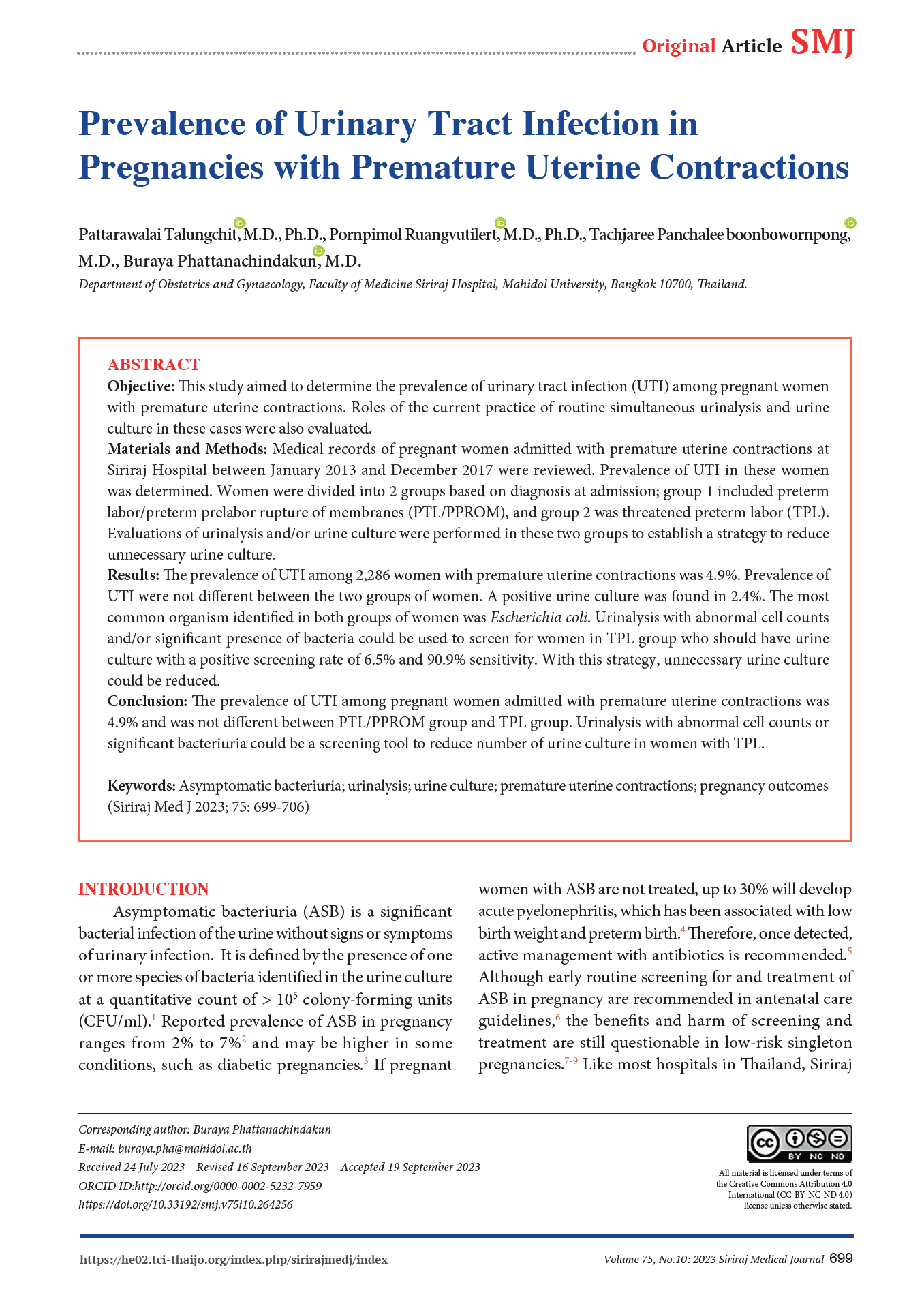Prevalence of Urinary Tract Infection in Pregnancies with Premature Uterine Contractions
DOI:
https://doi.org/10.33192/smj.v75i10.264256Keywords:
Asymptomatic bacteriuria, urinalysis, urine culture, premature uterine contractions, pregnancy outcomesAbstract
Objective: This study aimed to determine the prevalence of urinary tract infection (UTI) among pregnant women with premature uterine contractions. Roles of the current practice of routine simultaneous urinalysis and urine culture in these cases were also evaluated.
Materials and Methods: Medical records of pregnant women admitted with premature uterine contractions at Siriraj Hospital between January 2013 and December 2017 were reviewed. Prevalence of UTI in these women was determined. Women were divided into 2 groups based on diagnosis at admission; group 1 included preterm labor/preterm prelabor rupture of membranes (PTL/PPROM), and group 2 was threatened preterm labor (TPL). Evaluations of urinalysis and/or urine culture were performed in these two groups to establish a strategy to reduce unnecessary urine culture.
Results: The prevalence of UTI among 2,286 women with premature uterine contractions was 4.9%. Prevalence of UTI were not different between the two groups of women. A positive urine culture was found in 2.4%. The most common organism identified in both groups of women was Escherichia coli. Urinalysis with abnormal cell counts and/or significant presence of bacteria could be used to screen for women in TPL group who should have urine culture with a positive screening rate of 6.5% and 90.9% sensitivity. With this strategy, unnecessary urine culture could be reduced.
Conclusion: The prevalence of UTI among pregnant women admitted with premature uterine contractions was 4.9% and was not different between PTL/PPROM group and TPL group. Urinalysis with abnormal cell counts or significant bacteriuria could be a screening tool to reduce number of urine culture in women with TPL.
References
Schmiemann G, Kniehl E, Gebhardt K, Matejczyk MM, Hummers-Pradier E. The diagnosis of urinary tract infection: a systematic review. Dtsch Arztebl Int. 2010;107(21):361-7.
Nicolle LE, Gupta K, Bradley SF, Colgan R, DeMuri GP, Drekonja D, et al. Clinical Practice Guideline for the Management of Asymptomatic Bacteriuria: 2019 Update by the Infectious Diseases Society of America. Clin Infect Dis. 2019;68(10):e83-e110.
Alvarez JR, Fechner AJ, Williams SF, Ganesh VL, Apuzzio JJ. Asymptomatic bacteriuria in pregestational diabetic pregnancies and the role of group B streptococcus. Am J Perinatol. 2010;27(3):231-4.
Moore A, Doull M, Grad R, Groulx S, Pottie K, Tonelli M, et al. Recommendations on screening for asymptomatic bacteriuria in pregnancy. CMAJ. 2018;190(27):E823-E30.
Smaill FM, Vazquez JC. Antibiotics for asymptomatic bacteriuria in pregnancy. Cochrane Database Syst Rev. 2019;2019(11):CD000490.
Force USPST, Owens DK, Davidson KW, Krist AH, Barry MJ, Cabana M, et al. Screening for Asymptomatic Bacteriuria in Adults: US Preventive Services Task Force Recommendation Statement. JAMA. 2019;322(12):1188-94.
Kazemier BM, Koningstein FN, Schneeberger C, Ott A, Bossuyt PM, de Miranda E, et al. Maternal and neonatal consequences of treated and untreated asymptomatic bacteriuria in pregnancy: a prospective cohort study with an embedded randomised controlled trial. Lancet Infect Dis. 2015;15(11):1324-33.
Angelescu K, Nussbaumer-Streit B, Sieben W, Scheibler F, Gartlehner G. Benefits and harms of screening for and treatment of asymptomatic bacteriuria in pregnancy: a systematic review. BMC Pregnancy Childbirth. 2016;16(1):336.
Srisompong J, Rahman S, Russameecharoen K, Tongsai S, Seenama C, Koomanachai P. Prevalence and Accuracy of Screening Test of Asymptomatic Bacteriuria During Pregnancy in Siriraj Hospital. Open Forum Infect Dis. 2017;4(Suppl 1):S348.
Chawanpaiboon S, Kanokpongsakdi S. Preterm Birth at Siriraj Hospital: A 9-Year Period Review (2002-2010). Siriraj Med J. 2011;63(5):143-6.
Bentley DL, Bentley JL, Watson DL, Welch RA, Martin RW, Gookin KS, et al. Relationship of uterine contractility to preterm labor. Obstet Gynecol. 1990;76(1 Suppl):36S-8S.
American College of Obstetricians and Gynecologists' Committee on Practice B-O. Prediction and Prevention of Spontaneous Preterm Birth: ACOG Practice Bulletin, Number 234. Obstet Gynecol. 2021;138(2):e65-e90.
The Management of Preterm Labour and Preterm Premature Rupture of Membranes [Internet]. RTCOG Clinical Practice Guideline. 2017. Available from: http://www.rtcog.or.th/home/ob-014-%e0%b8%81%e0%b8%b2%e0%b8%a3%e0%b8%94%e0%b8%b9%e0%b9%81%e0%b8%a5%e0%b8%a3%e0%b8%b1%e0%b8%81%e0%b8%a9%e0%b8%b2%e0%b8%a0%e0%b8%b2%e0%b8%a7%e0%b8%b0%e0%b9%80%e0%b8%88%e0%b9%87%e0%b8%9a%e0%b8%84/396/.
Bastek JA, Sammel MD, Srinivas SK, Elovitz MA. Is routine infectious and toxicologic screening in preterm labor effective in predicting preterm birth? Am J Obstet Gynecol. 2008;198(5):e38-42.
Chalermchockchareonkit A, Phoethong S, Ruangvutilert P, Thamkhantho M. Prevalence of positive culture of genitourinary tract microorganisms in pregnant women with presumptive preterm labor. J Med Assoc Thai. 2013;96(9):1111-8.
Hundley AF, Onderdonk AB, Greenberg JA. Value of routine urine culture in the assessment of preterm labor. J Reprod Med. 2003;48(11):853-7.
Komaroff AL. Acute dysuria in women. N Engl J Med. 1984;310(6):368-75.
Cohen RA, Brown RS. Clinical practice. Microscopic hematuria. N Engl J Med. 2003;348(23):2330-8.
Kiatsuda D, Thinkhamrop J, Prasertcharoensuk W. Success rate in preterm uterine contraction inhibition with tocolytic agents in a tertiary care center. Int J Womens Health. 2016;8:663-7.
Kamel HAH, Hegab MHM, Al-sehrawey AA-s, Hassan HM. Prevalence of Asymptomatic Bacteriuria in Patients with Preterm Labor. The Egyptian Journal of Hospital Medicine. 2018;73(9):7444-7.
Nicolle LE. Asymptomatic bacteriuria: when to screen and when to treat. Infect Dis Clin North Am. 2003;17(2):367-94.
Prevention of Group B Streptococcal Early-Onset Disease in Newborns: ACOG Committee Opinion, Number 797. Obstet Gynecol. 2020;135(2):e51-e72.

Published
How to Cite
License
Copyright (c) 2023 Siriraj Medical Journal

This work is licensed under a Creative Commons Attribution-NonCommercial-NoDerivatives 4.0 International License.
Authors who publish with this journal agree to the following conditions:
Copyright Transfer
In submitting a manuscript, the authors acknowledge that the work will become the copyrighted property of Siriraj Medical Journal upon publication.
License
Articles are licensed under a Creative Commons Attribution-NonCommercial-NoDerivatives 4.0 International License (CC BY-NC-ND 4.0). This license allows for the sharing of the work for non-commercial purposes with proper attribution to the authors and the journal. However, it does not permit modifications or the creation of derivative works.
Sharing and Access
Authors are encouraged to share their article on their personal or institutional websites and through other non-commercial platforms. Doing so can increase readership and citations.














